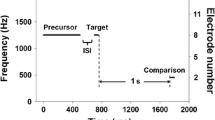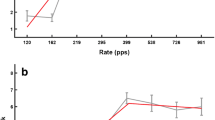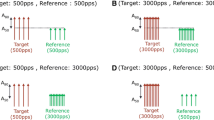Abstract
Context effects in loudness have been observed in normal auditory perception and may reflect a general gain control of the auditory system. However, little is known about such effects in cochlear-implant (CI) users. Discovering whether and how CI users experience loudness context effects should help us better understand the underlying mechanisms. In the present study, we examined the effects of a long-duration (1-s) intense precursor on the loudness relations between shorter-duration (200-ms) target and comparison stimuli. The precursor and target were separated by a silent gap of 50 ms, and the target and comparison were separated by a silent gap of 2 s. For normal-hearing listeners, the stimuli were narrowband noises; for CI users, all stimuli were delivered as pulse trains directly to the implant. Significant changes in loudness were observed in normal-hearing listeners, in line with earlier studies. The CI users also experienced some loudness changes but, in contrast to the results from normal-hearing listeners, the effect did not increase with increasing level difference between precursor and target. A “dual-process” hypothesis, used to explain earlier data from normal-hearing listeners, may provide an account of the present data by assuming that one of the two mechanisms, involving “induced loudness reduction,” was absent or reduced in CI users.





Similar content being viewed by others
References
Arieh Y, Marks LE (2003a) Time course of loudness recalibration: implications for loudness enhancement. J Acoust Soc Am 114:1550–1556
Arieh Y, Marks LE (2003b) Recalibrating the auditory system: a speed-accuracy analysis of intensity perception. J Exp Psychol Hum Percept Perform 29:523–536
Arieh Y, Kelly K, Marks LE (2005) Tracking the time to recovery after induced loudness reduction. J Acoust Soc Am 117:3381–3384
Bingabr M, Espinoza-Varas B, Loizou PC (2008) Simulating the effect of spread of excitation in cochlear implants. Hear Res 241:73–79
Clark NR, Brown GJ, Jurgens T, Meddis R (2012) A frequency-selective feedback model of auditory efferent suppression and its implications for the recognition of speech in noise. J Acoust Soc Am 132:1535–1541
Cooper NP, Guinan JJ Jr (2003) Separate mechanical processes underlie fast and slow effects of medial olivocochlear efferent activity. J Physiol 548:307–312
de Boer J, Thornton AR, Krumbholz K (2012) What is the role of the medial olivocochlear system in speech-in-noise processing? J Neurophysiol 107:1301–1312
Elmasian R, Galambos R (1975) Loudness enhancement: monaural, binaural, and dichotic. J Acoust Soc Am 58:229–234
Elmasian R, Morgan R, Galambos R (1975) Time course of loudness enhancement and intensity discrimination. J Acoust Soc Am 58:S35–S35
Elmasian R, Galambos R, Bernheim A Jr (1980) Loudness enhancement and decrement in four paradigms. J Acoust Soc Am 67:601–607
Galambos R, Bauer J, Picton T, Squires K, Squires N (1972) Loudness enhancement following contralateral stimulation. J Acoust Soc Am 52:4
Garinis AC, Glattke T, Cone BK (2011) The MOC reflex during active listening to speech. J Speech Lang Hear Res 54:1464–1476
Glasberg BR, Moore BC (1990) Derivation of auditory filter shapes from notched-noise data. Hear Res 47:103–138
Guinan JJ Jr (2006) Olivocochlear efferents: anatomy, physiology, function, and the measurement of efferent effects in humans. Ear Hear 27:589–607
Guinan JJ Jr (2010) Cochlear efferent innervation and function. Curr Opin Otolaryngol Head Neck Surg 18:447–453
Hong RS, Rubinstein JT (2006) Conditioning pulse trains in cochlear implants: effects on loudness growth. Otol Neurotol 27:50–56
Hong RS, Rubinstein JT, Wehner D, Horn D (2003) Dynamic range enhancement for cochlear implants. Otol Neurotol 24:590–595
Jennings SG, Strickland EA, Heinz MG (2009) Precursor effects on behavioral estimates of frequency selectivity and gain in forward masking. J Acoust Soc Am 125:2172–2181
Mapes-Riordan D, Yost WA (1999) Loudness recalibration as a function of level. J Acoust Soc Am 106:3506–3511
Marks LE (1988) Magnitude estimation and sensory matching. Percept Psychophys 43:511–525
Marks LE (1994) “Recalibrating” the auditory system: the perception of loudness. J Exp Psychol Hum Percept Perform 20:382–396
Mishra SK, Lutman ME (2014) Top-down influences of the medial olivocochlear efferent system in speech perception in noise. PLoS ONE 9:e85756
Nieder B, Buus S, Florentine M, Scharf B (2003) Interactions between test- and inducer-tone durations in induced loudness reduction. J Acoust Soc Am 114:2846–2855
Oberfeld D (2007) Loudness changes induced by a proximal sound: loudness enhancement, loudness recalibration, or both? J Acoust Soc Am 121:2137–2148
Oberfeld D (2008) The mid-difference hump in forward-masked intensity discrimination. J Acoust Soc Am 123:1571–1581
Oxenham AJ, Kreft HA (2014) Speech perception in tones and noise via cochlear implants reveals influence of spectral resolution on temporal processing. Trends Hear 18. pii: 2331216514553783
Plack CJ (1996) Loudness enhancement and intensity discrimination under forward and backward masking. J Acoust Soc Am 100:1024–1030
Scharf B, Buus S, Nieder B (2002) Loudness enhancement: induced loudness reduction in disguise? (L). J Acoust Soc Am 112:807–810
Wang N, Kreft H, Oxenham AJ (2012) Vowel enhancement effects in cochlear-implant users. J Acoust Soc Am 131:EL421–EL426
Zeng FG (1994) Loudness growth in forward masking: relation to intensity discrimination. J Acoust Soc Am 96:2127–2132
Zwislock JJ, Sokolich WG (1974) Loudness enhancement of a tone burst by a preceding tone burst. Percept Psychophys 16:87–90
Acknowledgments
This work was supported in part by NIH grant R01 DC012262. Author NW was supported by Advanced Bionics and by a Doctoral Dissertation Fellowship from the Graduate School of the University of Minnesota.
Conflict of Interest
The authors declare that they have no conflict of interest.
Author information
Authors and Affiliations
Corresponding author
Rights and permissions
About this article
Cite this article
Wang, N., Kreft, H.A. & Oxenham, A.J. Loudness Context Effects in Normal-Hearing Listeners and Cochlear-Implant Users. JARO 16, 535–545 (2015). https://doi.org/10.1007/s10162-015-0523-y
Received:
Accepted:
Published:
Issue Date:
DOI: https://doi.org/10.1007/s10162-015-0523-y




